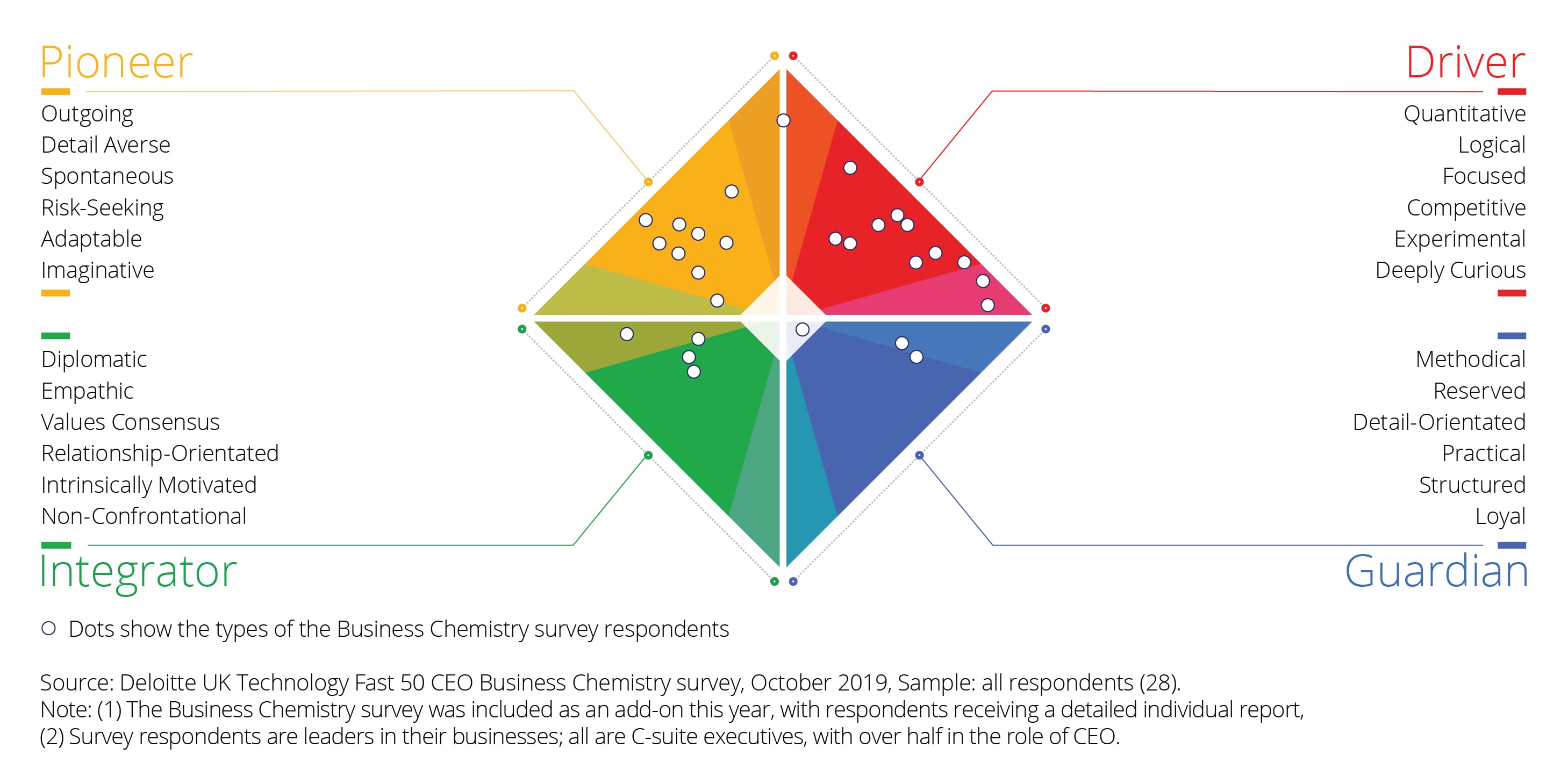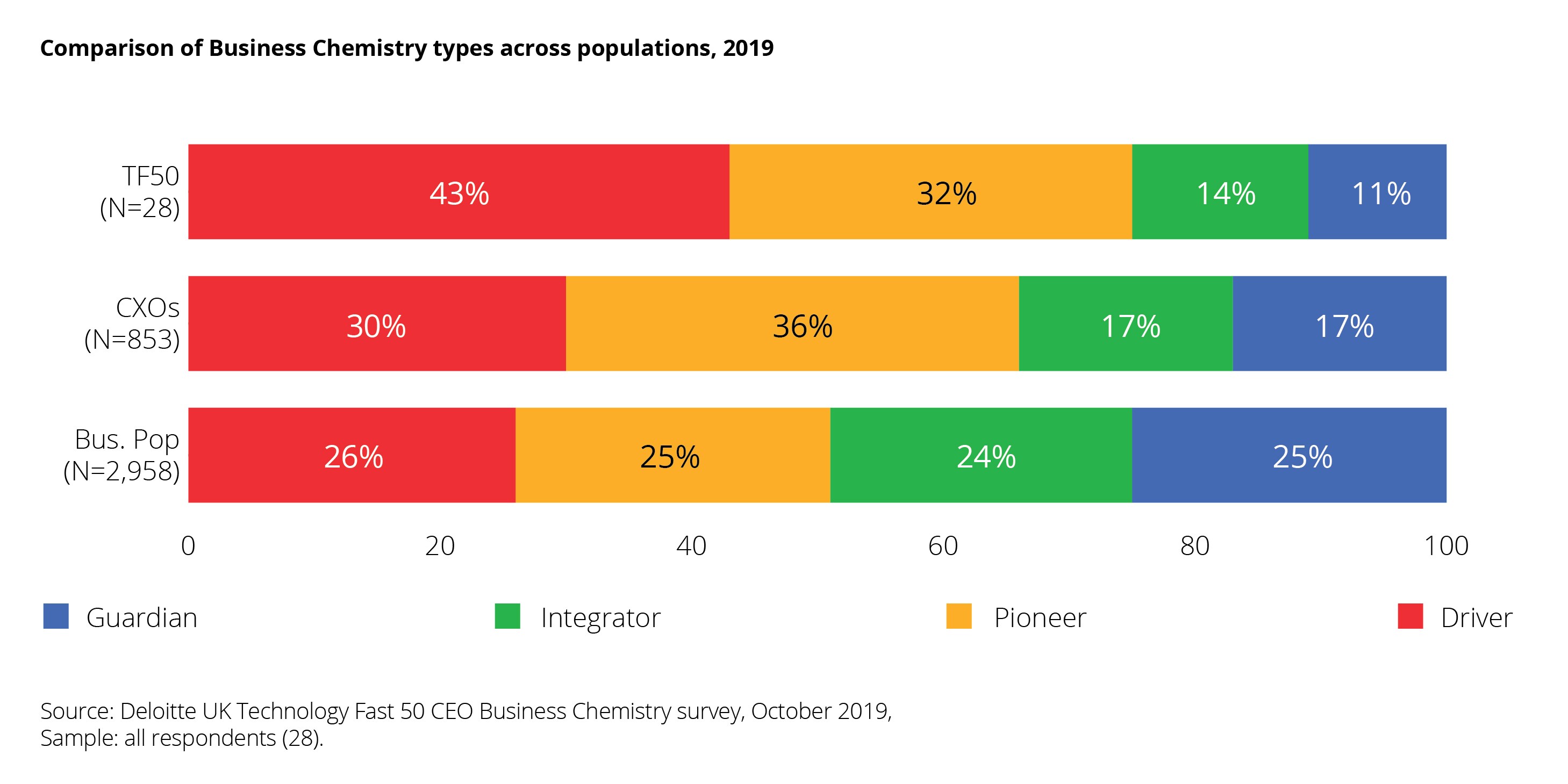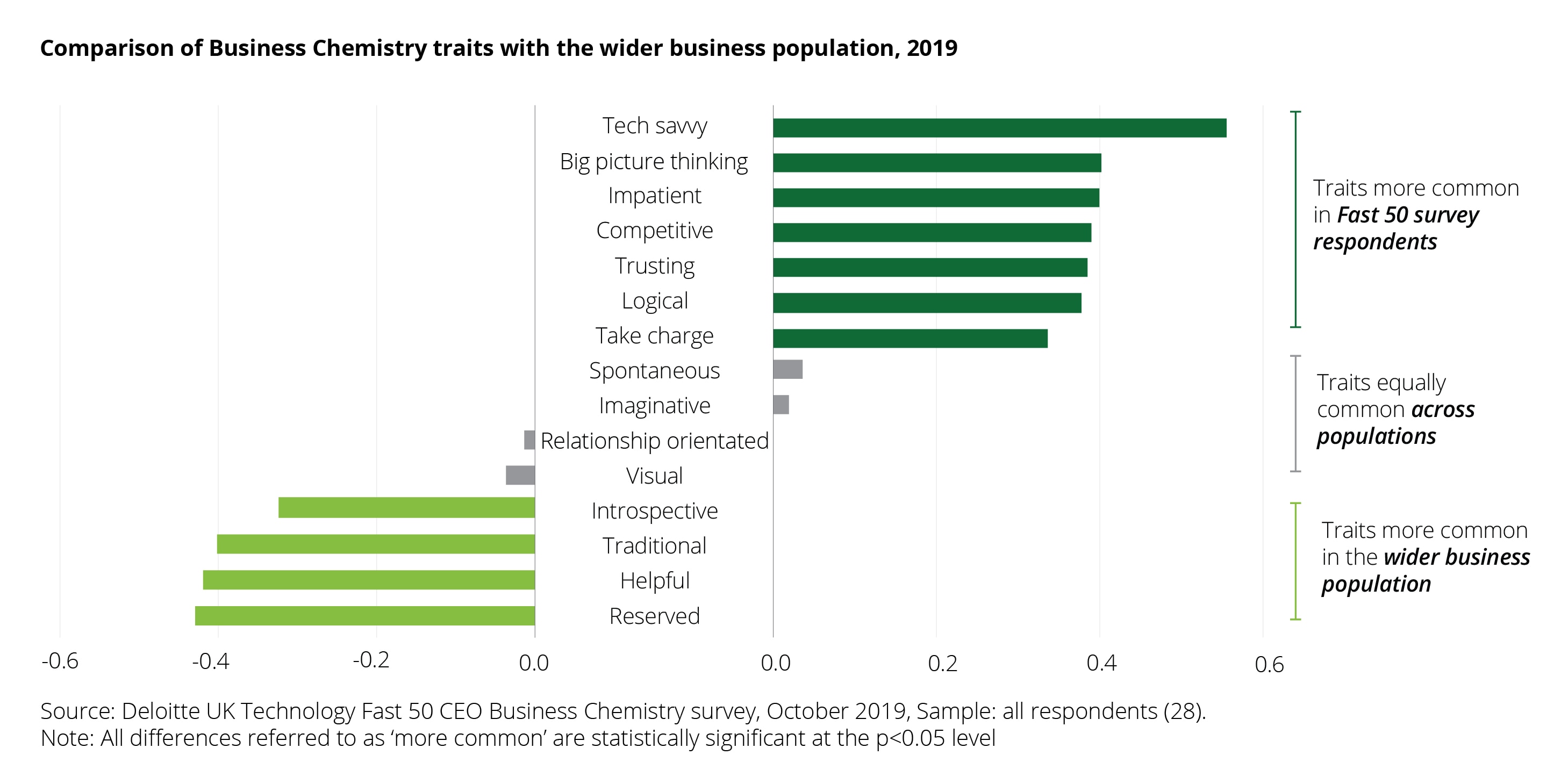Traits at the top: What makes a tech CEO? | Deloitte UK has been saved
This article is an excerpt from our 2019 Technology Fast 50 insights report, which takes a deeper look at the profile, experience and traits of the CEOs leading the UK’s fastest growing tech companies.
Visit the Fast 50 page to learn more, see sources, or register for next year’s programme.
This year we have used Deloitte’s Business Chemistry behavioural preferences tool to uncover the different working styles and traits of the leaders of the Fast 50. Whilst there is no exact formula behind these successful leaders, our findings show that this talented group of leaders are more likely than the wider business population to enjoy exploring different possibilities, value challenge, logically assess problems, and maintain composure through stressful times.
An individual’s working style has a significant impact on their perspective, approach to relationships and means of making decisions. Business Chemistry provides a fresh approach to explore working styles and understand how to set up the right teams to realise success. Designed for use in a working context, Business Chemistry explicitly focuses on observable, business‑relevant characteristics and their implications.
The science behind Business Chemistry reveals four primary types, each of which brings different and useful approaches for managing and growing a business.
An individual’s working style has a significant impact on their perspective, approach to relationships and means of making decisions.
Of course, not every individual fits perfectly into one of the types, and we expect most people to be a composite of all four. Whilst some individuals show a strong presence of one or two types, others spread evenly across all.

The Fast 50 Business Chemistry survey respondents are leaders in their businesses; all are C‑suite executives, with over half in the role of CEO. Figure 5 helps us to unpick the working styles of the respondents and is interpreted as follows:
The quadrant within which an individual appears represents the primary Business Chemistry type to which they most closely align. The closer an individual appears to the outside border, the stronger their primary type (or combined primary and secondary types). Across Fast 50 survey respondents, Drivers and Pioneers are most common, representing 43 per cent and 32 per cent respectively.
The quick decision‑making, logical solutions and push for action of Drivers are clear traits associated with the preconception of a leader, especially those in fast‑paced industries reacting to constant change. Likewise, the typical traits of Pioneers, creativity and risk‑taking, are likely to help technology companies to break industry norms and build innovative, exciting products and ideas. Whilst Drivers and Pioneers are most common among entrants, every primary Business Chemistry type is represented among our leaders. The empathy and diplomacy of Integrators can enable and empower their teams, powering collective success, whilst Guardians bring a rigorous, structured and practical approach to their work and provide stable foundations for teams to develop around.
The proximity of an individual to the horizontal and vertical lines shows the strength of their secondary Business Chemistry type. There are multiple Fast 50 survey respondents with strong secondary Business Chemistry types, for example, there are several Driver‑Guardians and Pioneer‑Integrators. Only the combination of Guardian and Integrator is not observed in our sample. This supports the idea that there is no cookie‑cutter style to running a fast‑growing business, and that different approaches to leadership and management can, and do, succeed.
Deloitte’s Business Chemistry study of over 850 CXOs, paired with the baseline sample of nearly 3,000 business professionals offer points of comparison for the Fast 50 survey respondents. The CXO study aligns with our survey findings, with Drivers and Pioneers being the most populous types, cumulatively representing 66 per cent of respondents. Our sample differs in that it has a higher proportion of Drivers. In comparison with the wider business population, both the Fast 50 and CXO samples have fewer Guardians and Integrators.

Business Chemistry also allows us to dig deeper into the traits and characteristics commonly exhibited by leaders. Across the range of Business Chemistry types, the survey assesses the presence of 68 traits. Among our respondents, one of the most common traits is ‘exploratory’, which often manifests itself in the desire to investigate new ideas and approaches. This is clearly present in the wider market of technology leaders. LinkedIn CEO, Jeff Weiner, reportedly spends up to one‑and‑a‑half hours per day processing and thinking, whilst Bill Gates undertakes a twice‑ yearly “Think Week” to consider technological advancements and new ideas15, 16.
Other highly common traits are ‘quantitative’, ‘logical’ and ‘composed’; painting a diverse picture of characteristics exhibited by leaders. We cannot say whether these traits make the survey respondents good leaders, or indeed great leaders, but can only recognise that our leaders, exhibiting high levels of these traits, have made it to the top and developed successful, ultra‑high growth businesses.
As well as considering traits that are most common among leaders, we can also compare the presence of traits with the wider business population. In Figure 7, traits on the right‑hand side are more prevalent in our sample of leaders, whilst those on the left‑hand side are more common in the wider business population. It is reassuring to find that our sample is statistically more ‘tech savvy’ – this is the Technology Fast 50 after all – as well as being prone to ‘take charge’ and engage in ‘big picture thinking’, both traits commonly associated with the role of a leader or visionary.
We can see that the survey respondents are statistically less ‘reserved’ and less ‘helpful’. The former is unsurprising given the need to inspire and communicate with employees and investors. In the wider business population, being ‘helpful’ may be a product of working within larger teams or for someone more senior. There are also ways in which the leadership is not so different from the wider business population. The research suggests that they are not more or less relationship‑ orientated, spontaneous or visual.
It is reassuring to find that our sample is statistically more ‘tech savvy’ – this is the Technology Fast 50 after all – as well as being prone to ‘take charge’ and engage in ‘big picture thinking’, both traits commonly associated with the role of a leader or visionary.

Significant differences with the CXO population are most apparent in the approach to teaming, with the Fast 50 survey respondents statistically more ‘trusting’, but less ‘collaborative’. Further studies, with larger samples sizes, may uncover more differences. In particular it may be beneficial to understand the traits associated with ‘creating the top’, as many of our Fast 50 have done, versus ‘taking over the top’. The latter is common in long‑standing corporations where succession is an important factor in all leadership discussions.
Naturally, starting to unpick the working styles and traits leads to the question of how did the traits develop? It is expected that both nature and nurture play a role. Deloitte Business Chemistry practitioners recognise both biological and socialisation theories as possible explanations for the development of traits early in life. Some Business Chemistry types are more common among specific generations or genders. It is also possible that these traits develop over time, either naturally or as the result of active self‑development, a hypothesis supported by our discussions with Fast 50 CEOs.
This resonates with the technology entrepreneur Ben Horowitz, who believes that it “generally takes years for a founder to develop the CEO skill set”. These leaders were not born, but made over time, and continue to develop alongside the business they lead. This is particularly true for traits that the leaders are less inclined to, but have learned to draw on when needed.
The Fast 50 leadership cohort exhibit specific traits, and each individual will have gaps in others. Self‑awareness of their ability helps the Fast 50 leaders to draw on complementary skills and experience of those around them to unlock the full potential of high‑performing teams. The next section explores the roles of the CEOs, and the following they create around them to drive growth.
These leaders were not born, but made over time, and continue to develop alongside the business they lead.
Check out the full insights report to read more or visit the UK Technology Fast 50 page to see past winner’s lists or to apply for next year’s programme.
Key contact

Duncan Down
Duncan Down is a Transaction Services Partner with nearly 20 years experience of supporting clients on transactions. He leads Deloitte’s Financial Advisory TMT business in the UK, and works extensively with both corporate and private equity investors on acquisitions, disposals and refinancings. He has led numerous international transactions across the Americas, EMEA and AsiaPac, as well as for overseas investors making acquisitions in the UK and Europe. Duncan also leads our Emerging Growth Companies team in the UK, which provides support to VC, VC backed and high growth companies as they scale and internationalise. He has for the last four years led our UK Tech Fast 50 programme, which for 25 years has identified and celebrated the fastest growing UK technology companies.

